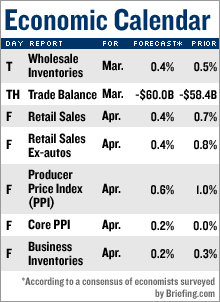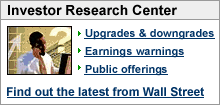Keeping the bull runningThe Dow has seen its longest run of gains in nearly 80 years. Can it continue in the week ahead as investors mull earnings, inflation news and the next Fed meeting?NEW YORK (CNNMoney.com) -- Earnings, mergers and supportive economic news have been powering the stock market in recent weeks, and there's not much in the week ahead to suggest an end to the advance. The Federal Reserve meeting Wednesday is the big highlight of the week. But with Ben Bernanke and the central bankers expected to hold interest rates steady and keep mum about any possible future rate cuts, Fed Day may not have as much sway as it often does. The last of the earnings trickle in this week with Cisco (Charts, Fortune 500), Walt Disney (Charts, Fortune 500), Toll Brothers (Charts, Fortune 500), Viacom (Charts) and a few others. However, the bulk of the first-quarter results have already been reported, have easily trounced estimates, and have made all the dour predictions of a big earnings slowdown look a bit overwrought - at least for the first quarter. (Full story). So what's likely to keep the advance going next week, or at least stem any profit-taking selloff? Momentum and liquidity, mixed with a healthy splash of skepticism. "There's still a lot of money on the sidelines just waiting for minor dips to step in," said Fred Dickson, chief market strategist at D.A. Davidson & Co. "The earnings have been strong and merger mania seems to be the rule of the day." But are investors too optimistic right now to notice the warning signs? Missives from the housing market continue to distress, the dollar's plunge to record lows against the euro is good for big multi-national companies but not necessarily for others, and the pace of the economic slowdown remains in question. Sure the earnings were decent - with 81 percent of the S&P 500 having reported, earnings are on track to have risen 8.1 percent from a year ago, according to the latest Thomson Financial estimates. That's better than the 3.3 percent expected on April 1, but still marks the slowest quarter of earnings growth in more than 3-1/2 years. Yet, the sentiment is positive enough right now that investors were able to take Friday's April jobs report - which showed the smallest monthly payrolls growth in more than two years - and turn it into a positive. Stock and bond investors seemed to bet that the slower April payrolls growth - paired with signs of lower wage inflation also within the report - means the Federal Reserve is likely to lower rates sooner than it is to raise them. However, not next week. Next week, the central bank is widely expected to keep the Fed funds rate, a key overnight bank lending rate unchanged at 5.25 percent for the seventh meeting in a row. (Full story). The board members are likely to see the jobs report as backwards looking, said Joshua Shapiro, chief economist at Maria Fiorini Ramirez Inc. That's especially the case since strong reports on manufacturing and factory orders released earlier last week suggested that the labor market is only one piece of the growth picture. As always, the accompanying statement will be of greater concern to investors. "They'll talk about the recent mixed data and say that they are still concerned about inflation," said Shapiro. "But I don't think the bias statement will have any surprises." "The bottom line is that people won't view the statement as implying they are going to move one way or the other," he said. In terms of other economic news due during the week, retail sales and the Producer Price Index are on tap, but not until the end of the week. (See chart for details). Stocks ended last week at 2007 highs, with the Dow Jones industrial average (Charts) closing at a record for the 7th out of 8 sessions as part of a longer winning streak. The Dow has now closed higher for 23 out of the last 26 sessions, the longest upward run since the summer of 1927, according to Dow Jones. The S&P 500 (Charts) is within reach of its all time-high of 1527.46 hit in March of 2000, right near what would prove to be the top for the late 1990's tech boom-fueled run. The Nasdaq composite (Charts), though far from its tech boom-fueled high of 5048.62, also hit in March 2000, is doing just fine too. The tech-driven index ended last week at its highest point since February 2001. And the Russell 2000 (Charts) small-cap index sits just below an all-time high. After a big rally, a pullback is pretty typical, and the stock market could experience that as investors move into the typically slow and shaky summer months on Wall Street. But in the short term, there is still enough worry about the eventual pullback that it can probably be avoided a bit longer, said Todd Salamone, director of trading at Schaeffer's Investment Research. He said that from a contrarian point of view, stocks can continue to climb the "wall of worry" that Wall Streeters often refer to. "Even though the earnings have been positive and have driven the market over the short term, I don't think it changes the immediate outlook, which is cautious," Salamone said. He pointed to technical stats that Wall Street professionals look at, as well as the fact that investors have been pulling money out of stock index funds for five weeks straight, even as the market has been going up. "There's a cautionary tone in the middle of strong price action and strong earnings," Salamone said. "And that's bullish." |
|




